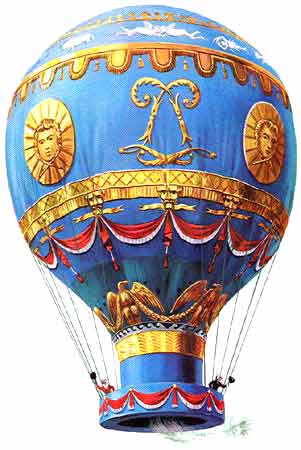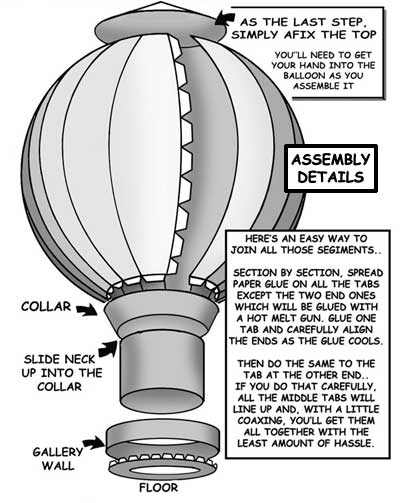


Montgolfier Brothers Hot Air Balloon
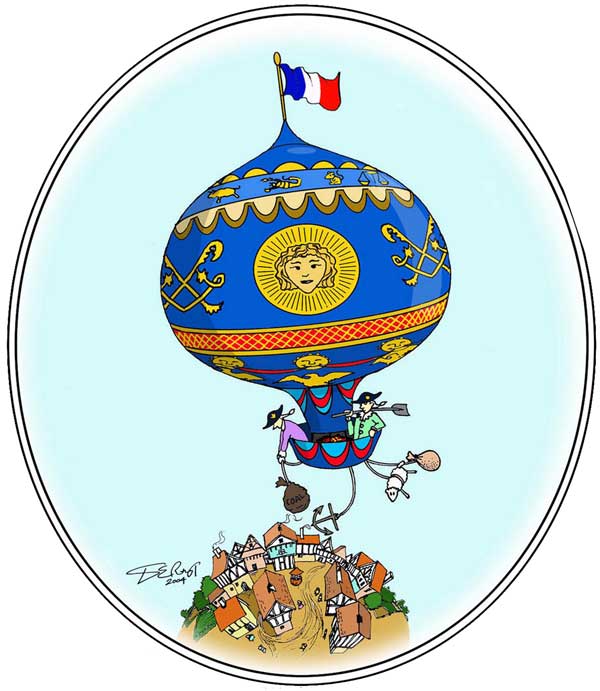
This original artwork by Derek Roberts is available in much higher quality (suitable for framing), on the Full Collection DVD.
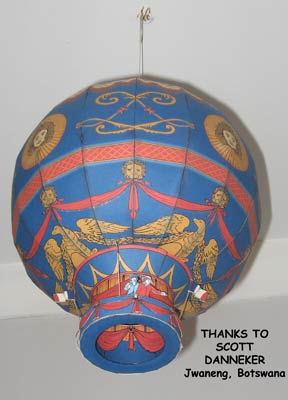
The Montgolfier brothers, born in Annonay, France, were inventors of the first practical balloon. Joseph-Michael, the elder, was born on August 26, 1740; Jacques-Etienne was born on January 6, 1745. They were 2 of the 16 children of Pierre Montgolfier, whose prosperous paper factories in the small town of Vidalon, near Annonay, in southern France, helped support their balloon experiments.
In 1782, the brothers discovered that heated air from a fire directed into a paper or fabric bag made the bag rise. They demonstrated this discovery in 1782 when a balloon they made rose into the air about 3,000 feet remained aloft some 10 minutes, and then settled to the ground more than a mile and a half from where it rose.
On
September 19, in a demonstration before Louis XVI and Marie Antoinette,
they put a sheep, duck, and rooster aboard a balloon to determine
the effect of altitude on living creatures. The balloon floated
for about 8 minutes and landed safely about 2 miles from the launch
site.
I bought the balloon model and it was fantastic! It is currently hovering over my son's train set. It is truly beautiful. I would recommend, though, that you alter the instructions to recommend that hot glue be used for the entire balloon assembly, not just the end tabs. There is just too much pressure for paper glue to work on those in between tabs. Thanks again for great fun. Jackie
OUTSTANDING! This is beautiful. Enjoyed the history....Bob P
Chip, the art on this piece is a piece of art!! Beautiful, excellent job, as always, just more excellent than usual;-).....Anthony How about some paper sheep and chickens, who were really the first passengers?!....DF Montgolfier Balloon...WOW!....Dave D
This is a very colorful model that I am sure the children would love to have in the hospital rooms. Very nice work. Dennis B
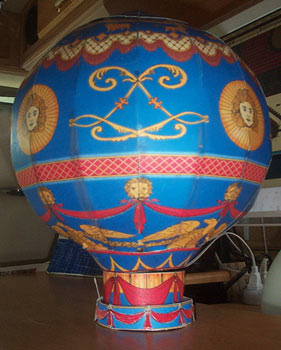
Thank you. It really is impressive. I can't wait to build it. I couldn't help noticing the FG mouse's face on the balloon. I always wondered where your logo came from. Now I know.--David
In studying that balloon, I'm trying to figure out where they got the image of that cross-eyed mouse? hehehehe Duck of elder estates
Hi, It's getting harder to come up with new adjectives for your creations. I'm down to a single "WOW!!", which probably says it all but still doesn't seem adequate. Thanks for the hours of pleasure, the happiness of children who enjoy receiving the results and even the anticipation of 'what's next?' Some of what I've received lately is being saved for our winter (read 'rainy') season but the B-25 will be attacked on receipt. Can't wait. Dan.
Hi Chip...I found that if you make a duplicated copy and cut out the lions and then paste them back over top of the lions on the model it adds some real nice depth to the model. Beautiful Model by itself and just an extra touch sure makes it wonderful...also you can tie thread around the balloon to stabilize and anchor to the basket...Herman
This is absolutely GORGEOUS! I'm planning to build one right away. Oh, I do have one historical question -- if this depicts a 1783 balloon that Louis XVI witnessed, why is it flying the French Tricolor? Shouldn't it be the pre-Revolutionary Fleurs-de-lis? Again, FANTASTIC work! Bravo! David O
As always, I was most impressed with the quality of your model of the Montgolfier Balloon, thanks. It seems that the Brothers Montgolfier did more than sail the first balloon, they also discovered the 13th sign of the zodiac as I noticed on the top band around the balloon, a cross eyed mouse. What could be the name of this sign? Fiddelerius? Best regards, Dick B. The Netherlands
C'est magnifique! ymp, John
Chip, you have really out done yourself this time. The balloon is truly a work of art. Kudos. I think even my wife will enjoy this one as much as me....Thanks....John
The Montgolfier Hot Air Balloon- first to carry people
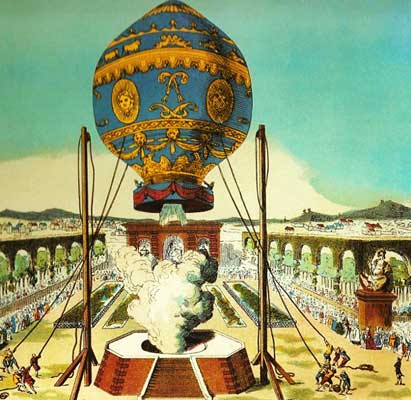
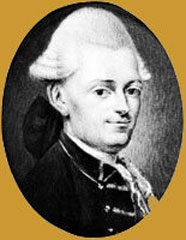
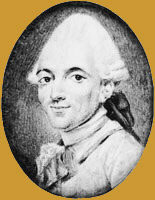 Many stories,
doubtless fanciful, have been told to explain the way in which
Etienne and Joseph Montgolfier discovered that hot air rises,
and how they concluded that if contained in an envelope of sufficient
size it would have enough 'lift' to raise passengers into the
air.
Many stories,
doubtless fanciful, have been told to explain the way in which
Etienne and Joseph Montgolfier discovered that hot air rises,
and how they concluded that if contained in an envelope of sufficient
size it would have enough 'lift' to raise passengers into the
air.
The choice of paper for the envelope of their first must have seemed natural to the brothers, who were paper-makers by trade. The balloon, fairly rigid, stood over a pit containing wool and straw which when ignited filled the balloon's envelope with hot air. On 25 April 1783, the first successful Montgolfiere took to the air at Annonay near Lyons in France. It is reported to have risen to a height of about 1,000 feet and traveled about 3,000 ft horizontally before it fell to the ground as the air in the envelope cooled.
The bothers gave a public demonstration at Annonay on 4 June 1783, when a new balloon rose to about 6,000 feet. This success resulted in a summons to the capital, so that King Louis XVI could see the Montgolfier's invention for himself. A balloon some 42 feet in diameter was constructed especially for the event, and a basket hung beneath it to carry the world's first aerial voyagers: a rooster, a duck, and a sheep.
The balloon was launched at the Court of Versailles on 19 September 1783, climbing to approximately 1800 feet before the astonished gaze of King Louis, Marie Antoinette and their court. It landed about 2 miles away, and there was some concern when the rooster was discovered to be a little the worse for his adventure. Had he been weakened by the great altitude at which the balloon had flown? Further investigation suggested that he was probably suffering form the effects of being trampled or sat on by the sheep.
The moment was fast approaching for manned flight, for which the Montgolfiers created a magnificent new balloon 49 feet in diameter. Superbly decorated in a blue-and-gold color scheme, it was emblazoned with the royal cipher, signs of the zodiac, eagles and smiling suns. Around its open neck was attached a wicker gallery capable of accommodating one or two men. In this vehicle the 26-year-old Francois Pilatre de Rozier made a tethered flight to 85 feet on 15 October 1783 and remained airborne for about 4.5 minutes.
Just over a month later, on 21 November 1783, de Rozier and his passenger, the Marquis d' Alandes, became the first men in the world to be carried in free flight by a balloon. They rose from the garden of the Chateau La Muette in the Bois de Boulogne, Paris, and were airborne for 25 minutes before managing to land about 5 miles away from their departure point.
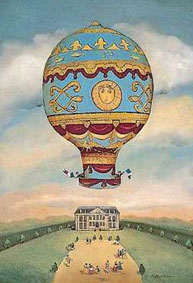
Joseph Montgolfier, born in August 1740 and Etienne Montgolfier born five years later were brothers in a family of sixteen children. Their father was a paper manufacturer, owner of a factory at Viladon-les-Annonay, south of Lyon, France.
Throughout history, humankind has looked at the clouds and dreamed of what it would be like to be among them, looking down. Joseph observed the sky, too, and had the idea to get some paper from the factory, made a large bag, filled it with steam, and produced a sodden mass of paper.
Etienne's imagination was also stirred. From scientific reading, he had the idea of making a bag float in the air with hydrogen gas obtained from sulphuric acid and iron filings. Still no success.
Experimenting indoors, in November 1782, Joseph achieved
a small-scale success using a taffeta envelope filled with hot
air rise to the ceiling. Now the dream of the Montgolfier brothers
seemed in reach. With more taffeta, rope, and
high 'hopes, they prepared a large-scale experimental balloon.
Joseph and Etienne Montgolfier, saw their hopes becoming reality with the first public demonstration on 4 June 1783. Their first step was taken when their hot-air balloon took off from Annonay, France. The 28,251 cubic feet balloon rose to a height of 3,281 feet, and traversed a distance of two kilometers. It was made of cloth, lined with paper, coated with alum as fireproofing, and its several segments held together by about 2,000 buttons.
The balloon flight was a success even though the physics was not well understood by the brothers. They believed that smoke provided the lift for the light fabric balloon. Thus, the balloon was filled by smoke from a fire of straw, humidified wool and even of old shoes! The more dense the smoke, the better, they thought. Only later was it realized that it was the hot air provided by the fire that mattered, not the smoke.
For a second test, a new balloon of 49,440 cubic feet was built. The demonstration took place in Paris in the presence of King Louis XVI on September 19, 1783. Three passengers - a rooster, a duck and a sheep - were used as guinea-pigs in order to test the effect of high altitude on live creatures. The king was not impressed by the stench of the dense smoke, but this flight, too, proved to be a great success. The balloon rose to a height of 1,640 feet and traversed 1.9 miles.
After many experiments, the Montgolfier brothers, Joseph-Michel (1740-1810) and Jacques-Etienne (1745-1799), French inventors, built the first hot-air balloon to make an unmanned ascent lasting ten minutes to a height of 5,906 feet above the marketplace at Annonay on June 5, 1783. Unlike modern-day hot-air balloons, the hot air necessary for lift was provided not by a gas burner beneath the opening of the envelope but by a fire on the ground.
The first aeronauts were Jean-Francois Pilatre de Rozier and Marquis Francois d'Arlandes. They made the first manned balloon ascent over Paris in November of the same year in a balloon made by the Montgolfier brothers.
Why flight?
Since the beginning of time, man has wanted to float through
the sky like a bird. From fashioning huge feathered wings to creating
complex machines, many people have tried to take to the skies
unsuccessfully throughout history. However, it was the Montgolfier
brothers of France that discovered 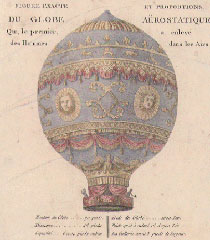 the secret.
the secret.
What was the secret?
The Montgolfier brothers were paper makers in France in the 1700's.
It is said that one of the brothers got the idea for creating
a balloon after watching an article of clothing being lifted into
the air from the smoke of a nearby fireplace. Their balloon project
was begun.
How did it work?
The brothers, using paper and linen, constructed their balloon.
On June 5th of 1783, a crowd gathered to watch as they positioned
it over an open straw fire, hoping the balloon would fill with
hot smoke and float away, proving their theory. To everyone's
amazement, it worked! What many spectators didn't know was that
it wasn't the smoke that was making the balloon soar.
What causes balloons to fly?
In reality, it was the heat generated by the fire that caused
their little balloon to fly over the countryside of France. When
the air inside of a balloon is heated more than the air outside
the balloon, it is less dense, and therefore rises. That explains
the name "lighter than air flight" - the air inside
the balloon is lighter than the rest!
Who were the first balloon passengers?
After several more test flights, the Montgolfier Brothers decided
it was time to send some passengers aloft. The first balloon passengers
were not people - but a duck, a chicken, and a sheep! Then, on
November 21st, 1783, a physicist named Jean-Francois Pilatre de
Rozier and an army major named the Marquis Francois d'Arlandes
took flight in a Montgolfier balloon. The flight was watched by
nearly all of Paris, including King Louis XVI, and Marie Antoinette!
After 25 magical minutes of flight, they landed safely outside
Paris, and with much celebration.
Birth of the Gas Balloon
It was a short time later, in December of 1783, that another adventurous
man, Jacques Alexandre Charles, made an ascension in a different
type of balloon - the gas balloon. Charles' balloon was similar
in shape, but instead of being filled with hot air from a fire,
it was filled with lighter than air hydrogen gas. This style of balloon is referred to as a "Charliere" balloon,
named for Charles.
After one of the Montgolfier brothers sent up a small test balloon, Charles ascended safely from the Tuileries Gardens with one passenger, the Duke of Chartres. After a successful two hour journey, Charles dropped his passenger off and ascended to a height of some 9,000 feet! His success left many scientific minds to wonder which aeronaut's methods were the most favorable - the Montgolfier's or Charles'?
The first "ride balloon"
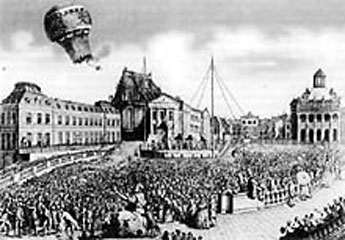 There was a great deal of interest and experimentation going on
in France at this time. Everyone wanted to master this mysterious
and magical art of flying. In 1784, Joseph Montgolfier launched
a new, giant balloon called "La Flesselles" from Lyons.
Its 22 foot wide wicker basket carried 7 passengers aloft to a
height of over 3,000 feet. It is said that though the flight was
a bit rough at times, all passengers were thrilled with the voyage.
There was a great deal of interest and experimentation going on
in France at this time. Everyone wanted to master this mysterious
and magical art of flying. In 1784, Joseph Montgolfier launched
a new, giant balloon called "La Flesselles" from Lyons.
Its 22 foot wide wicker basket carried 7 passengers aloft to a
height of over 3,000 feet. It is said that though the flight was
a bit rough at times, all passengers were thrilled with the voyage.
Ballooning spreads across the globe
Experimental flights were now being conducted in nearly all of
Europe. Both men and women adventurers built balloons to take
them to the skies. Balloon mania even reached the United States,
and in June of 1784, the first aerial voyage was made in the States
from Baltimore. The passenger was a 13 year old boy.
